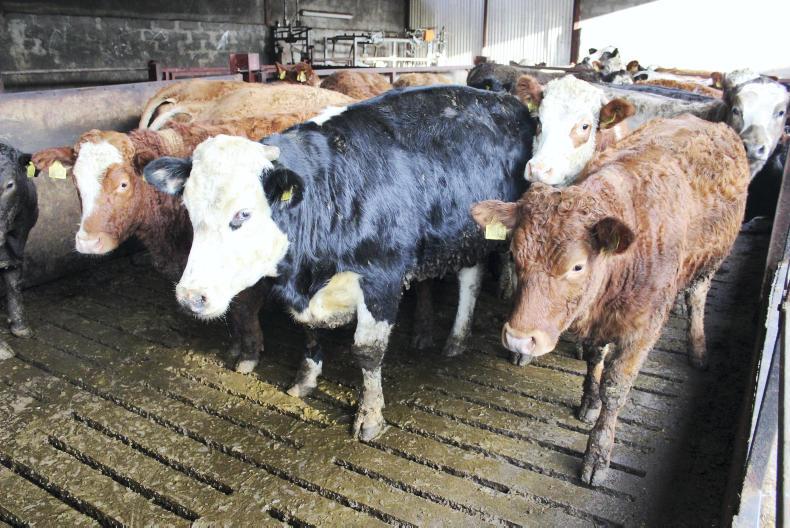Spring-born heifers that will be put to the bull next year should be managed as a separate group over winter to ensure they met growth targets.
When trying to calve at 24 months of age, getting the heifer to a heavy enough breeding weight is a challenge.
Heifers that are light at breeding will be under stress when they calve, as they are not fully developed. Coping with demands of milk production and their own body maintenance makes it more difficult to get these heifers back in calf again.
This is where the real problems with 24-month-old calving lie.
As a rule of thumb, heifers should be around 60% of mature cow weight at breeding time and 90% of mature cow weight at the time of first calving.
For a herd with 700kg to 750kg cows, this means a breeding weight of 420kg to 450kg and a calving weight of 630kg to 675kg.
This is roughly a lifetime gain of 0.8kg to 0.9kg/day from birth to breeding. Don’t forget that many farmers will finish heifers at 20-22 months of age, at weights of 600kg to 650kg.
So with the same herd genetics and good management, it should be possible to get heifers to 630kg liveweight by 24 months of age.
First winter
The key period to achieving this is in the first winter. Replacement heifers should be grouped separately from other stock and getting priority feeding management.
Heifers need to be gaining 0.6kg to 0.7kg/day during the winter period. A heifer born on 1 April and housed at 260kg liveweight on 1 October should weigh approximately 310kg to 320kg by the end of December.
This leaves a weight gain of 100kg to 120kg between January and breeding time in June or July.
Heifers should be on top-quality silage and 2kg/day of ration at the moment. Cut the ration by 50% around six weeks before your planned turnout date. Then cut the ration from the diet completely around two weeks prior to turnout.
Give the heifer group priority to go back to grass, as the longer grazing period will help them reach target breeding weight.
Second winter
In the second winter, heifers should again be managed separately from the main cow herd, as cows will dominate heifers indoors. This will prevent heifers from getting adequate feed, meaning some animals are getting insufficient energy from the diet.
These heifers are more likely to calve down well short of target weight, making it much more difficult to go back in calf again.
Heifers should have adequate feeding space so that all animals can feed at the same time in the group.
Once calved, ensure heifers are properly supplemented with concentrates for a short period, until they can move on to high-quality grazing swards.
Read more
Five New Year resolutions for beef farmers
Tullamore Farm: kale, meal and farm manager wanted
Ten jobs for Christmas on a beef farm
Spring-born heifers that will be put to the bull next year should be managed as a separate group over winter to ensure they met growth targets.
When trying to calve at 24 months of age, getting the heifer to a heavy enough breeding weight is a challenge.
Heifers that are light at breeding will be under stress when they calve, as they are not fully developed. Coping with demands of milk production and their own body maintenance makes it more difficult to get these heifers back in calf again.
This is where the real problems with 24-month-old calving lie.
As a rule of thumb, heifers should be around 60% of mature cow weight at breeding time and 90% of mature cow weight at the time of first calving.
For a herd with 700kg to 750kg cows, this means a breeding weight of 420kg to 450kg and a calving weight of 630kg to 675kg.
This is roughly a lifetime gain of 0.8kg to 0.9kg/day from birth to breeding. Don’t forget that many farmers will finish heifers at 20-22 months of age, at weights of 600kg to 650kg.
So with the same herd genetics and good management, it should be possible to get heifers to 630kg liveweight by 24 months of age.
First winter
The key period to achieving this is in the first winter. Replacement heifers should be grouped separately from other stock and getting priority feeding management.
Heifers need to be gaining 0.6kg to 0.7kg/day during the winter period. A heifer born on 1 April and housed at 260kg liveweight on 1 October should weigh approximately 310kg to 320kg by the end of December.
This leaves a weight gain of 100kg to 120kg between January and breeding time in June or July.
Heifers should be on top-quality silage and 2kg/day of ration at the moment. Cut the ration by 50% around six weeks before your planned turnout date. Then cut the ration from the diet completely around two weeks prior to turnout.
Give the heifer group priority to go back to grass, as the longer grazing period will help them reach target breeding weight.
Second winter
In the second winter, heifers should again be managed separately from the main cow herd, as cows will dominate heifers indoors. This will prevent heifers from getting adequate feed, meaning some animals are getting insufficient energy from the diet.
These heifers are more likely to calve down well short of target weight, making it much more difficult to go back in calf again.
Heifers should have adequate feeding space so that all animals can feed at the same time in the group.
Once calved, ensure heifers are properly supplemented with concentrates for a short period, until they can move on to high-quality grazing swards.
Read more
Five New Year resolutions for beef farmers
Tullamore Farm: kale, meal and farm manager wanted
Ten jobs for Christmas on a beef farm






 This is a subscriber-only article
This is a subscriber-only article









SHARING OPTIONS: